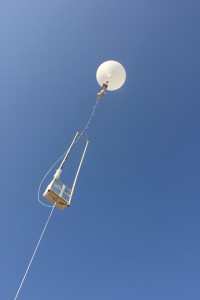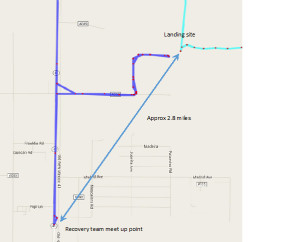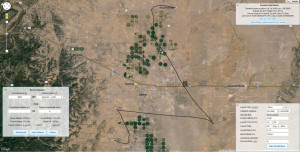NMSS-16
Introduction
NMSS-16 was originally scheduled to be launched on August 8th (along with NMSS-17 and NMSS-18) as part of the 2015 Duke City Hamfest. NMSS-17 and NMSS-18 were scheduled to be launched from the hamfest venue in Albuquerque while NMSS-16 was scheduled to be launched from a remote location. However, weather in the launch area forced the NMSS-16 launch to be scrubbed and rescheduled for August 29.
A video recap of the launch is available on the NMSS YouTube channel. The YouTube version has lost a bit of quality. A full resolution version may be downloaded from here.
Still images are available on the NMSS Flicker site
Flight Stats
- Flight date: August 29, 2015
- Launch time: 8:40:06 AM local time
- Burst time: 9:59:48
- Land time: 10:26:40
- Launch Location: Stanley New Mexico (35.148, -105.978)
- Landing point: South of Moriarty (34.949, -106.024) east of HW41 and north of A088.
- Balloon size: 1000g
- Filled with a single bottle of H2 which resulted in a neck lift at launch: 11.9 pounds
- Payload (8.13 pounds):
- Primary APRS transmitter (Byonics AIO, NM5SS-1)
- Experimental APRS transmitter (Kantronics MT1200, NM5SS-3)
- Camera package (Garmin VIRB, Contour Rohm, Mobius)
- 2M/440 Cross band repeater based on a Wouxun KG-UV8D
- Flight Computer (Sky Probe)
- Audio Beeper
- Max altitude: 91,484 feet (on-board flight computer GPS).
- Ascent rate: 5.5m/s average (1.8 min and 10.1 max averaged over a 10 second period)
- Decent rate: -16.1m/s average (-1.3 min and -64.9 max averaged over a 10 second period)
- Flight time 8:40:06 AM (launch) – 9:59:48 AM (burst) – 10:26:40 AM landing
Mission Description and Objective
The rescheduled launch was picture perfect. Skies were clear, temperatures were mild, and there were no surface winds.
The primary purpose of this mission was to test an experimental 2M / 440 cross band repeater. The repeater worked far better than anyone expected. It worked so well that the entire recovery operation was coordinated via the balloon hosted repeater instead of the normal terrestrial repeater network. In addition to recovery, we were able to QSO with K5UOT (Blaine Smith) in Clovis (about 160 miles away) at 8:55 (altitude at that time would have been about 26,000 feet). We were also able to QSO with KA7OFR (Kevin Nichols) in Placitas (about 40 miles away and behind the Sandia mountains). The QSO with Kevin was possible until the balloon reached an altitude of about 7000 feet during descent. In hind sight we should have coordinated with other hams to get a full test on the repeater range. The repeater antenna was a ladder line J-Pole antenna made by Dick Powell (AD5CS). The repeater worked during the entire descent. The repeater frequencies were:
- Up Link (user transmits on this frequency).
- 449.18MHz, no tone
- Down Link (user listens on this frequency)
- 147.76 (no tone)
Here is a picture of the repeater (click on the image for a hi-res version):
Dick nailed the prediction and balloon fill. Overall the flight path followed the predicted path fairly well – though it was compressed somewhat in the north / south direction. The recovery crew stationed them selves just east of highway 41 on Calle del Monte Rd. and watched the flight via APRS. The balloon landed approximately 2.8 miles to the north east of that location. The recovery team was able to drive to within about 0.2 miles of the landing site and walked in across a grass field the payloads. See the Google map below.
Here is the launch prediction
Launch and Recovery Team
(alphabetical order)
- Terry Hardin (KD5IDY)
- Trevor Hardin
- Twila Hardin
- Debbie Pendley (KD5LOK)
- Mike Pendley (K5ATM)
- Dick Powell (AD5CS)
- Una Powell
- Scott Stevenson (KC5VVB)
- Larry Zentner (NL7TO)



